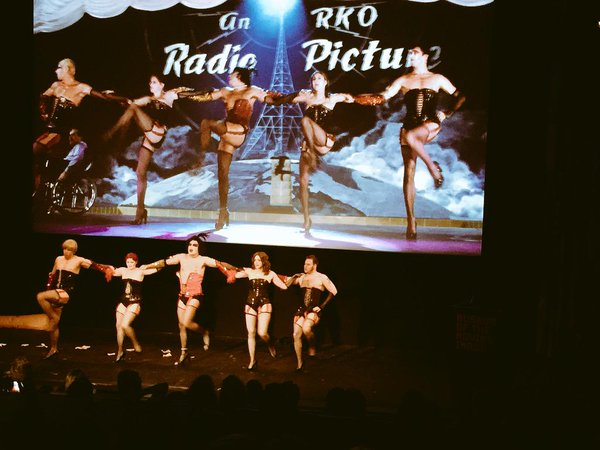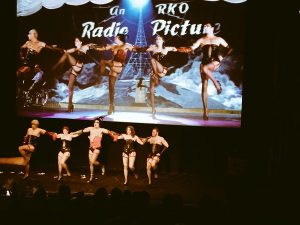
Breaking from the Screen

A shadow cast performance of “The Rocky Horror Picture Show”
In a time when almost everything is available online via illegal streaming, downloading, and Netflix, theaters are having trouble keeping up revenues. In 2014, revenues and theater attendance in North America was the lowest it has been since 1995 and even the United States’ revenue was down despite an average increase in ticket prices. The MPAA’s Market and figures for 2014 broke down this number even more, showing how in Europe, North America, and Africa that theater attendance and revenue has dropped overall in at least the past four years, and in Asia Pacific attendance and revenue has been increasing. However, until January of this year many of the nations in Asia Pacific did not have Netflix yet and China still does not. The lack of attendance at theaters corresponds with the rise of Netflix and the correlation should be tracked in these newly added countries in the future. In the meantime, with Movie Theater attendance decreasing the filmmakers of both experimental and feature films need to consider a new way to display films as an audience can now watch a movie anywhere and anytime with only a connection to internet. Some theaters have moved to building more spacious theaters with reclining seats or making the dinner and movie all happen in the theater. If theaters want to continue to be relevant they need to make going to the movies an experience that cannot be recreated at home, by incorporating elements such as food or performers that cannot be replicated.
Expanded cinema could be an option for the future of movie theaters. expanded cinema is a broad term that can be summarized as cinema that is not passively watched from a movie theater seat. A well known example is the shadow cast performances of The Rocky Horror Picture Show (1975, Jim Sharman). It does not have any singular beginning but appears to have emerged during the 1960s with a film being shown on the interior walls and ceiling of a grain silo thereby changing the way the audience perceived the film. The key idea behind expanded cinema being to make film more of an active experience, where the audience is aware of what they are seeing and how it was made. A film could be created with this in mind, or can be shown in an “expanded” setting. As with many things in film expanded cinema was at first avant garde and experimental, but now it has branched out to a wider audience if not yet the mainstream moviegoers.
Some creative entities such as New Media Scotland have embraced expanded cinema, but other filmmakers, such as Sarah Turner, believe it undermines the artist’s initial intent. In a meeting with Mark Daniels, the creative director of New Scotland Media, he introduced some interesting takes on expanded media, such as with a showing of Barbarella (1968, Roger Vadim). In their showing they recreated part of the set in a gallery space where the film was shown on a central wall, and during a portion of the film where a character on screen offers food people from New Media Scotland dressed like that character and offered food to the audience. He said that it was interesting and the audience appeared to enjoy it, and was actively engaged. However, this is probably not what Roger Vadim had in mind, when he made the film – a point Sarah Turner discussed in her discussion with William Raban at the Lizzie Borden Regrouping: Discussions event during the 2016 Edinburgh International Film Festival. Turner stated that some films she had seen in museums in an expanded cinema style would make artists “roll over in their graves,” because it undermines the original intent. She also said that even though this mode of presentation allows more viewers to see the film, the film should not be shown in such a style. So where does this leave entities such as New Media Scotland that are constantly creating ways of expanding cinema and including the audience? In giving new life to old films, are they undermining the artist’s intent or creating a more engaging experience for an audience to view films?
Two examples of the expanded cinema at the 2016 Edinburgh International Film Festival occurred during Black Box Shorts sections I and II attended. The first was Pending by director Bea Haut (UK, 2016), where she pulled the 35mm film from the projector, until the end and asked the audience to hold it up as the projector ran and an image of her holding a ladder was projected. Haut stated in the question and answers after that the point was for the audience to relate the weight of the film to the image of her holding the heavy ladder in the moving image. The second was Primal by Vicky Smith (UK, 2016), where the animated film consisted of scratches on exposed film with the filmmaker’s fingernail and a Foley artist produced sounds to go with the film so the audience could see how the sounds were created. This makes each showing unique because each screening offers a singular soundtrack. Both of these showings of films include the audience in ways that modern feature films in large commercial cinemas do not. However, getting a large crowd at a cinema to handle delicate film might be challenging and secret cinema is expensive, charging roughly £67 with more optional charges once inside, and not able to be offered as often or to as large a group of people. Secret cinema recreates a film in a large space, for example in showings of Back to the Future (1985, Robert Zemeckis) the town square is recreated and actors also perform the roles of Doc (Christopher Lloyd) and Marty (Michael J. Fox) while the film is also showing. None of these ideas are exactly accessible yet for large commercial theater chains media, but they should be considered as new films are produced.
Most current examples of expanded cinema in newer productions still exist in the experimental and avant garde realm, but it has also been incorporated into rescreenings of The Rocky Horror Picture Show with shadow casts, or secret cinema with their showings of Star Wars: The Empire Strikes Back (Irvin Kershner, 1980) and other films. However, none of these are the new blockbusters that Hollywood is creating. These forms of expanded cinema take passion and time to develop, and feature films are not being created to interact with the crowd. For expanded cinema to be a viable and large scale economic success filmmaker need to create a film that interacts with the audience somehow, be it food or actors shadow casts. Filmmakers should begin to explore this option, or come up with new ways of engaging audiences beyond Imax and 3D if film is to continue to grow and thrive.
Comments are closed, but trackbacks and pingbacks are open.